Warns Non-Aviation Business Not Part Of Original 1962
Agreement
It's one of the last things you'd expect to see at an airport --
dozens of junkyards and used car lots lining the field on airport
property. Yet at San Diego's Brown Field (SDM), that's exactly what
you see, and the Federal Aviation Administration has been trying to
do something about it.

For years city officials have allowed tenants with no aviation
background to occupy leased space on the airport, contending the
rental income from the leases is what helps maintain the airport.
The FAA sees the use of airport property for non-aviation
enterprise as gross misuse of the airport, a violation of the 1962
government grant of the airport to the city, and a reason for the
agency to reject federal grant money. As a result, the potentially
vibrant general aviation airport is now stagnant as the FAA and the
city and state officials attempt to resolve the situation.
In 2006, city officials began the process of evicting the
non-aviation businesses on the field due to pressure from the FAA.
However, the process halted when Councilman Ben Hueso, who
represents the region, helped stop the evictions after being
bombarded with complaints from the tenants according to the San
Diego Union-Tribune.
A compromise was formed in April 2006, allowing "right-of-entry"
permits for non-conforming tenants to stay on the field. Officials
insisted this was only temporary and their business would only be
tolerated for one more year.
"We will be specific and totally clear that this is a one-year
deal -- end of story," former land-use chief James Waring wrote at
the time.
The FAA agreed to the permits, but only as a temporary solution
and reinforced the evictions needed to continue for the airport to
conform to the 1962 agreement.
According to the Union-Tribune, Rep. Bob Filner, D-San Diego,
approached the FAA in March about allowing the junkyards to stay,
saying it makes no sense to force viable businesses off Brown Field
until the city has more definitive plans for the property.
"You have some pretty incompetent (city) administrations giving
out these nonconforming leases for years," Filner said. "Now all of
a sudden this has to be reversed even when there are no immediate
development plans?"
Ironically the process of planning the future of the airport is
why evictions have halted since the 2006 compromise.
In early 2007, three months before the "right-of-entry permits"
were set to expire, San Diego Mayor Jerry Sanders announced "the
first significant new development" at Brown Field since the city
took over.
The new plan called for developers to bid on rebuilding 65 acres
south of the runway and also to recommend solutions for the whole
airport. At the time, Sanders' office acknowledged that most of the
non-aviation companies would probably be allowed to stay past the
one-year deadline.
All evictions are halted during the development planning
process.
A $2.1 Million FAA grant application currently under review could
be threatened if the evictions don't continue. Sanders blames City
Attorney Michael Aguirre for halting the latest eviction process.
Aguirre said the Mayor's Office agreed to stop the evictions while
planning is under way for the airport.
As a result of the confusion, non-compliant tenants south of the
runway are now in legal limbo. Targeted first for eviction, their
leases were canceled when the eviction process began, so they no
longer pay rent or provide the city proof they are insured against
accidents or injuries.
 The area where those 17
tenants are located is part of the initial phase of the
redevelopment plan being worked out between the city and developer
Distinctive Projects Co. Inc. Their plan would add terminals,
hangars and offices and a sweeping conference center, hotel and
industrial park. Over the next 20 years, Distinctive Projects would
redevelop much of the entire 880 acres.
The area where those 17
tenants are located is part of the initial phase of the
redevelopment plan being worked out between the city and developer
Distinctive Projects Co. Inc. Their plan would add terminals,
hangars and offices and a sweeping conference center, hotel and
industrial park. Over the next 20 years, Distinctive Projects would
redevelop much of the entire 880 acres.
This isn't the first time an ambitious plan has been devised for
the future use of the airport.
In the mid-1990s, San Diego officials looked at the historically
general and business aviation airport as a potential major
air-cargo hub. Over five years, City planners developed the idea,
which would have increased air traffic and added 11,000 new jobs.
But in 2001, then-Mayor Dick Murphy and the City Council
unanimously rejected the plan.
The new plan isn't being blessed by the entire aviation
community at the airport however.
Current tenants, such as the San Diego Flight Museum, worry that
smaller aviation enterprises may get squeezed out of the airport as
the city makes room for bigger enterprises.
"The little guy, I think, is going to get screwed in this deal,"
said museum President Reg Finch, who already pays 21 cents a foot
for his 9,000-square-foot sublease -- up to four times what
tenants pay at other municipal airports.
"Why do they have to give the whole airport away?" he said.
 ANN's Daily Aero-Linx (05.06.25)
ANN's Daily Aero-Linx (05.06.25) ANN's Daily Aero-Term (05.06.25): Ultrahigh Frequency (UHF)
ANN's Daily Aero-Term (05.06.25): Ultrahigh Frequency (UHF) ANN FAQ: Q&A 101
ANN FAQ: Q&A 101 Classic Aero-TV: Virtual Reality Painting--PPG Leverages Technology for Training
Classic Aero-TV: Virtual Reality Painting--PPG Leverages Technology for Training Airborne 05.02.25: Joby Crewed Milestone, Diamond Club, Canadian Pilot Insurance
Airborne 05.02.25: Joby Crewed Milestone, Diamond Club, Canadian Pilot Insurance




